22nd JULY 1947 INDIAN NATIONAL FLAG APPROVED GOVERNMENT OF INDIA
During the 19th century, India was under British rule and a variety of flags were used by rulers of independent states in India, before the Indian independence movement began. It was after the Revolt of 1857 that the idea of a common Indian flag was proposed by the British. The first flag based on British symbols, also known as the Star of India was a group of flags used for different purposes by the British during their rule in India.
By the 20th century, around the time Edward VII was crowned king, it was decided that a symbol was required which represented the Indian Empire (as India was known then). It was around the same time that Indian nationalists thought that the flag required a religious symbol. Popular symbols at that time were that of Lord Ganesh, Goddess Kali or Gau Mata (the holy cow). These symbols were rejected on the grounds that they were Hindu centric, something to which Indian Muslims would find hard to relate.
The first Partition of Bengal in 1905 gave rise to a new Indian flag which aimed at uniting the people of India, irrespective of the caste, creed or religion they belonged to. This flag, known as the Vande Mataram flag, composed of Indian religious symbols, represented in a Western heraldic fashion. Launched during the Swadeshi movement against the British, this flag had eight white lotuses on the top white band (representing the eight provinces), a sun and a crescent on the bottom green band and the Bande Mataram slogan in the middle yellow band. This new flag was launched in Calcutta (now Kolkata) and barely received any coverage in the newspapers. The flag was used at the annual session of the Indian National Congress, though in the long run, it failed to gather nationalist sentiments among people.
Another proposal for the National Flag was suggested by Scottish Hindu reformist Sister Nivedita. This flag consisted of a thunderbold running through the middle and 108 oil lamps running along the border, with the Vande Mataram caption split across the border. This flag was also presented during the Indian National Congress meeting in 1906. This was followed by many other proposals for the national flag, but none attracted any attention from the nationalist movement. In 1916, Annie Besant and Bal Gangadhar Tilak recommended another national flag, which included the Union Jack at the top left hand corner, a star and crescent on the top right corner and seven stars diagonally from the lower right, placed against a backdrop of five red and four green alternating bands. This flag was banned by the Magistrate of Coimbatore, which was followed by a debate on the function and use of a national flag.
By the 1920s, it was Mahatma Gandhi’s desire to see all Indian communities represented on the flag of India, depicting a united country. A new flag was designed keeping these sentiments in mind. This flag comprised of a three colours: white on the top, green in the middle and red at the bottom. The colour white was to represent minority communities, green represented Muslims and red the Hindu and Sikh community. A charkha (spinning wheel) was drawn across all three colours symbolizing unity among all communities of India. Even though the Congress did not accept this flag, it was widely recognized as a symbol of patriotism and India’s struggle for freedom.
Not many people were happy with the communal representation with the flag proposed by Gandhi and, hence by 1931, another design was put forward for the national flag. This time the colour red had been replaced by ochre. This colour represented both Hindusim and Islam, since saffron was the colour of Hindu yogis as well as Muslim darvesh (dervish). But this led to the Sikh community demanding a separate colour for their religion as well, or a complete rejection of religious colours. This led to a new flag which was designed by Pingali Venkayya, an Indian freedom fighter. The new flag had three colours, saffron at the top, white in the middle and green at the bottom, with a charkha in between. The design of this flag was passed at a meeting of the Congress Committee in 1931 and was chosen as the official flag of the committee.
In 1947, when India gained freedom from the British, a committee headed by Dr. Rajendra Prasad decided to adopt the flag of the Congress as the national flag of India with a few modifications. With this in mind, the flag of 1931 was adopted as the national flag of India, but the charkha in the middle was replaced with the Ashoka Chakra. Thus, the Indian national flag was born. The saffron colour on top represents sacrifice, white represents truth, peace and purity and green signifies the law of dharma (righteousness).
Also On This Day:
1906: W.C. Bonnerjee, first President of Indian National Congress, passes away.
1977: Neelam Sanjiva Reddi is elected as President of India.
1988: Indian National Satellite (INSAT-1C) is launched.
National Flag

The National Flag is a horizontal tricolour of deep saffron (kesaria) at the top, white in the middle and dark green at the bottom in equal proportion. The ratio of width of the flag to its length is two to three. In the centre of the white band is a navy-blue wheel which represents the chakra.
The top saffron colour, indicates the strength and courage of the country. The white middle band indicates peace and truth with Dharma Chakra. The green shows the fertility, growth and auspiciousness of the land.
Its design is that of the wheel which appears on the abacus of the Sarnath Lion Capital of Ashoka. Its diameter approximates to the width of the white band and it has 24 spokes. The design of the National Flag was adopted by the Constituent Assembly of India on 22 July 1947.
It is really amazing to see the various changes that our National Flag went through since its first inception. It was discovered or recognised during our national struggle for freedom. The evolution of the Indian National Flag sailed through many vicissitudes to arrive at what it is today.
Know more about History of Indian Tricolor
The Indian National Flag symbolises national pride and is one of the most respectable national symbols. The late Prime MinisterJawaharlal Nehru called it "a flag not only of freedom for ourselves, but a symbol of freedom to all people."
As per the Indian laws, the national flag is to be made up of khadi. The Flag Code of India governs the usage of the flag. Initially the use of flag by private citizens was prohibited except on national days like Republic Day and Independence Day. But gradually some changes were made by the Union Cabinet about the usage of flag by private citizens. The code was amended about its usage for hoisting and its adaptation on other types of clothes.
The Indian national flag is popularly known as Tiranga which means "three colours". It is a horizontal tricolour in equal proportion of deep saffron at the top, white in the middle and green at the bottom. The ratio of the width to the length of the flag is 2:3. At the center of the white band, is a wheel with 24 spokes in navy blue colour that indicates the Dharma Chakra (the wheel of law).
Blank India Flag for Kids
The colours of the flag have a significance of their own:
Saffron: Saffron is the upper most colour of the flag and is a symbol of courage and selflessness.
White: The white colour in the Tiranga represents honesty, peace and purity. It highlights the importance of maintaining peace in the country.
Green: The green colour of the flag represents faith and chivalry. It is a symbolism of prosperity, vibrance and life.
Ashoka Chakra: The Ashoka Chakra or the Dharma Chakra (Wheel of Law) has 24 spokes and appears on the number of edicts of Ashoka.
The Indian national flag represents India's long struggle for freedom and is a national treasure. It signifies the status of India as an independent republic. The flag came into being in its present form at the meeting of Constitutional Assembly on 22 July 1947. Since then it has served as the National Flag of the Dominion of India from 15 August 1947 to 26 January 1950 and, thereafter, as the national flag of the Republic of India. The Indian National Flag was designed by Pingali Venkayya and contains three equal strips of saffron, white and green.
The history of the Indian National Flag over the years:
1904-06:: The history of the Indian flag dates back to pre-independence era. It was during 1904-06 that the first Indian flag came into being. It was made by an Irish disciple of Swami Vivekananda. Her name was Sister Nivedita and after some time this flag came to be known as Sister Nivedita's flag. This flag was coloured red and yellow. Red signified the freedom struggle and yellow was a symbol of victory. It had the words "Bonde Matoram" in Bengali written on it. Along with it the flag contained a figure of 'Vajra', weapon of god 'Indra', and a white lotus in the middle. The 'Vajra' is a symbol of strength and lotus depicts purity.
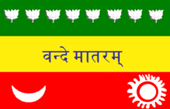 1906: After Sister Nivedita's flag, another flag was designed in 1906. It was a tricolour flag with three equal strips of blue (top), yellow (middle) and red (lower). In this flag the blue strip had eight stars of slightly different shapes. The red strip had two symbols, one of sun and the other of a star and a crescent. The yellow strip had 'Vande Mataram' written on it in Devnagiri script.
1906: After Sister Nivedita's flag, another flag was designed in 1906. It was a tricolour flag with three equal strips of blue (top), yellow (middle) and red (lower). In this flag the blue strip had eight stars of slightly different shapes. The red strip had two symbols, one of sun and the other of a star and a crescent. The yellow strip had 'Vande Mataram' written on it in Devnagiri script.
In the same year another version of this flag was created. It was also tricolour but its colours were different. It had orange, yellow and green and came to be known as 'Calcutta flag' or 'Lotus flag', as it had eight half opened lotuses on it. It is believed to be designed by Sachindra Prasad Bose and Sukumar Mitra. It was unfurled on 7 August 1906 at Parsi Bagan Square, Kolkata. It was a "boycott day" against the partition of Bengal and Sir Surendranath Banerjee hoisted this flag to mark the unity of India.
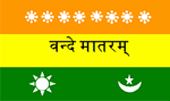 1907:Then came the Madam Bhikaji Rustom Cama's flag. The flag was collectively designed by Madam Bhikaji Cama, Vinayak Damodar Savarkar (Veer Savarkar) and Shyamji Krishna Varma. The flag was unfurled by Madam Cama on 22 August 1907 at Stuttgrat, Germany, and attained the status of the first Indian flag to be hoisted at the foreign land. From this event onwards it was also referred to as 'Berlin Committee flag'. The flag consisted of three colours- the topmost being green followed by golden saffron in the middle and the red colour at the bottom.
1907:Then came the Madam Bhikaji Rustom Cama's flag. The flag was collectively designed by Madam Bhikaji Cama, Vinayak Damodar Savarkar (Veer Savarkar) and Shyamji Krishna Varma. The flag was unfurled by Madam Cama on 22 August 1907 at Stuttgrat, Germany, and attained the status of the first Indian flag to be hoisted at the foreign land. From this event onwards it was also referred to as 'Berlin Committee flag'. The flag consisted of three colours- the topmost being green followed by golden saffron in the middle and the red colour at the bottom.
1916: In 1916 Pingali Venkayya, a writer and a geophysicist designed a flag with the intention to bring the whole nation together. He met Mahatma Gandhi and sought his approval. Mahatma Gandhi suggested him to incorporate a charkha as a symbol of economic regeneration of India, in the flag. Pingali made the flag out of the hand spun yarn 'Khadi'. The flag had two colours and a 'Charkha' drawn across them but Mahatma Gandhi did not approve of it as he said that the red represents the Hindu community and the green represents the Muslims, but all the other communities of India are not represented in this flag.
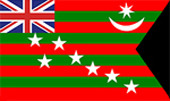 1917:The Home Rule League formed by Bal Gangadhar Tilak adopted a new flag in 1917, as at that time status of Dominion was being demanded for India. The flag had the union jack at the top, near the hoist. The rest of the flag contains five red and four blue strips. It had seven stars on it in the shape of 'Saptarishi' constellation which is supposed to be the sacred one for the Hindus. It also had a crescent moon and a star at the top fly end. This flag did not gain popularity among the masses.
1917:The Home Rule League formed by Bal Gangadhar Tilak adopted a new flag in 1917, as at that time status of Dominion was being demanded for India. The flag had the union jack at the top, near the hoist. The rest of the flag contains five red and four blue strips. It had seven stars on it in the shape of 'Saptarishi' constellation which is supposed to be the sacred one for the Hindus. It also had a crescent moon and a star at the top fly end. This flag did not gain popularity among the masses.
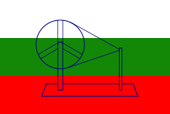 1921: As Mahatma Gandhi wanted all the communities of India to be represented in the flag of the nation, a new flag was designed. This flag had three colours. At the top was white then green and at the bottom was red colour. In this flag the colour white symbolised minority communities of India, green was for the Muslims and the red one was for the Hindu and Sikh communities. The 'Charkha' was drawn across all the bands symbolising the unification of these communities. The pattern of this flag was based on the flag of Ireland, another nation which was struggling to get its independence from the rule of Britain. Although the Congress Committee did not adopted it as its official flag but it was widely used as a symbol of nationality in India's freedom struggle.
1921: As Mahatma Gandhi wanted all the communities of India to be represented in the flag of the nation, a new flag was designed. This flag had three colours. At the top was white then green and at the bottom was red colour. In this flag the colour white symbolised minority communities of India, green was for the Muslims and the red one was for the Hindu and Sikh communities. The 'Charkha' was drawn across all the bands symbolising the unification of these communities. The pattern of this flag was based on the flag of Ireland, another nation which was struggling to get its independence from the rule of Britain. Although the Congress Committee did not adopted it as its official flag but it was widely used as a symbol of nationality in India's freedom struggle.
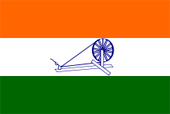 1931: Some people were not at all happy with the communal interpretation of the flag. Keeping all this in view, a new flag was designed which replaced red with ochre. This colour signified combined spirit of both the religions as saffron was the colour of Hindu yogis as well as Muslim darvesh. But the Sikh community also demanded a separate representation in the flag or the complete abandonment of religious colours. This resulted in another flag by Pingali Venkayya. This new flag had three colours. Saffron was at the top followed by white in the middle and green being the lowermost. The 'Charkha' was at the center of white colour. This flag was passed at the meeting of Congress Committee in 1931 and was adopted as the official flag of the Committee.
1931: Some people were not at all happy with the communal interpretation of the flag. Keeping all this in view, a new flag was designed which replaced red with ochre. This colour signified combined spirit of both the religions as saffron was the colour of Hindu yogis as well as Muslim darvesh. But the Sikh community also demanded a separate representation in the flag or the complete abandonment of religious colours. This resulted in another flag by Pingali Venkayya. This new flag had three colours. Saffron was at the top followed by white in the middle and green being the lowermost. The 'Charkha' was at the center of white colour. This flag was passed at the meeting of Congress Committee in 1931 and was adopted as the official flag of the Committee.
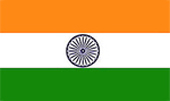 1947: When India got independence, a committee headed by Rajendra Prasad was formed to discuss the National Flag of India and they decided to adopt the flag of Indian National Congress, with suitable modifications, as the flag of India. As a result, the flag of 1931 was adopted as Indian flag but 'Charkha' in the middle was replaced by 'Chakra' (wheel) and hence our National Flag came into being.
1947: When India got independence, a committee headed by Rajendra Prasad was formed to discuss the National Flag of India and they decided to adopt the flag of Indian National Congress, with suitable modifications, as the flag of India. As a result, the flag of 1931 was adopted as Indian flag but 'Charkha' in the middle was replaced by 'Chakra' (wheel) and hence our National Flag came into being.
 British India Flag 1858-1947:This flag introduced by British India in 1858, whose design was based on western heraldic standards, was similar to flags of other British colonies, including Canada and Australia. The blue banner included the Union Flag in the upper-left quadrant and a Star of India capped by the royal crown in the middle of the right half.
British India Flag 1858-1947:This flag introduced by British India in 1858, whose design was based on western heraldic standards, was similar to flags of other British colonies, including Canada and Australia. The blue banner included the Union Flag in the upper-left quadrant and a Star of India capped by the royal crown in the middle of the right half.
Manufacturing: The 'Bureaue of Indian Standards (BIS)' sets standards for the manufacturing of the flag. It specifies the cloth, dye, colour, thread count and each and every thing about the flag, besides laying out rules regarding its hoisting. The Indian flag can only be made up of 'Khadi'. It is made up of two types of khadi one for its main part and the other one for the cloth which holds flag to the staff.
Code of Conduct Being a national symbol it is respected by every Indian. There are certain dos and don'ts laid down for common people regarding the Indian flag:
Some Interesting Facts
WBST100115
EBAKB100115
Last Updated on : January 20, 2015
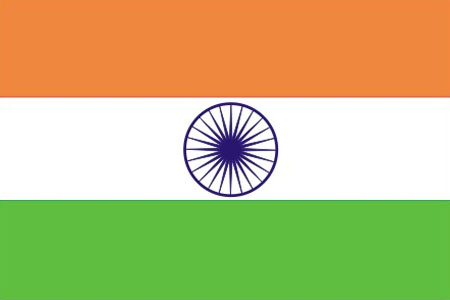 |
| Free Download Flag of India in different size | ||
 |  |  |
| Size:1024x600 | Size:1280x728 | Size:A4 |
 |  | |
| Tricolor Map of India | Download free Blank Indian flag to Color PDF Download free Blank Indian flag to Color GIF | |
As per the Indian laws, the national flag is to be made up of khadi. The Flag Code of India governs the usage of the flag. Initially the use of flag by private citizens was prohibited except on national days like Republic Day and Independence Day. But gradually some changes were made by the Union Cabinet about the usage of flag by private citizens. The code was amended about its usage for hoisting and its adaptation on other types of clothes.
The Indian national flag is popularly known as Tiranga which means "three colours". It is a horizontal tricolour in equal proportion of deep saffron at the top, white in the middle and green at the bottom. The ratio of the width to the length of the flag is 2:3. At the center of the white band, is a wheel with 24 spokes in navy blue colour that indicates the Dharma Chakra (the wheel of law).
Blank India Flag for Kids
The colours of the flag have a significance of their own:
Saffron: Saffron is the upper most colour of the flag and is a symbol of courage and selflessness.
White: The white colour in the Tiranga represents honesty, peace and purity. It highlights the importance of maintaining peace in the country.
Green: The green colour of the flag represents faith and chivalry. It is a symbolism of prosperity, vibrance and life.
Ashoka Chakra: The Ashoka Chakra or the Dharma Chakra (Wheel of Law) has 24 spokes and appears on the number of edicts of Ashoka.
History of Indian National Flag
The Indian national flag represents India's long struggle for freedom and is a national treasure. It signifies the status of India as an independent republic. The flag came into being in its present form at the meeting of Constitutional Assembly on 22 July 1947. Since then it has served as the National Flag of the Dominion of India from 15 August 1947 to 26 January 1950 and, thereafter, as the national flag of the Republic of India. The Indian National Flag was designed by Pingali Venkayya and contains three equal strips of saffron, white and green.
The history of the Indian National Flag over the years:
1904-06:: The history of the Indian flag dates back to pre-independence era. It was during 1904-06 that the first Indian flag came into being. It was made by an Irish disciple of Swami Vivekananda. Her name was Sister Nivedita and after some time this flag came to be known as Sister Nivedita's flag. This flag was coloured red and yellow. Red signified the freedom struggle and yellow was a symbol of victory. It had the words "Bonde Matoram" in Bengali written on it. Along with it the flag contained a figure of 'Vajra', weapon of god 'Indra', and a white lotus in the middle. The 'Vajra' is a symbol of strength and lotus depicts purity.
 1906: After Sister Nivedita's flag, another flag was designed in 1906. It was a tricolour flag with three equal strips of blue (top), yellow (middle) and red (lower). In this flag the blue strip had eight stars of slightly different shapes. The red strip had two symbols, one of sun and the other of a star and a crescent. The yellow strip had 'Vande Mataram' written on it in Devnagiri script.
1906: After Sister Nivedita's flag, another flag was designed in 1906. It was a tricolour flag with three equal strips of blue (top), yellow (middle) and red (lower). In this flag the blue strip had eight stars of slightly different shapes. The red strip had two symbols, one of sun and the other of a star and a crescent. The yellow strip had 'Vande Mataram' written on it in Devnagiri script.In the same year another version of this flag was created. It was also tricolour but its colours were different. It had orange, yellow and green and came to be known as 'Calcutta flag' or 'Lotus flag', as it had eight half opened lotuses on it. It is believed to be designed by Sachindra Prasad Bose and Sukumar Mitra. It was unfurled on 7 August 1906 at Parsi Bagan Square, Kolkata. It was a "boycott day" against the partition of Bengal and Sir Surendranath Banerjee hoisted this flag to mark the unity of India.
 1907:Then came the Madam Bhikaji Rustom Cama's flag. The flag was collectively designed by Madam Bhikaji Cama, Vinayak Damodar Savarkar (Veer Savarkar) and Shyamji Krishna Varma. The flag was unfurled by Madam Cama on 22 August 1907 at Stuttgrat, Germany, and attained the status of the first Indian flag to be hoisted at the foreign land. From this event onwards it was also referred to as 'Berlin Committee flag'. The flag consisted of three colours- the topmost being green followed by golden saffron in the middle and the red colour at the bottom.
1907:Then came the Madam Bhikaji Rustom Cama's flag. The flag was collectively designed by Madam Bhikaji Cama, Vinayak Damodar Savarkar (Veer Savarkar) and Shyamji Krishna Varma. The flag was unfurled by Madam Cama on 22 August 1907 at Stuttgrat, Germany, and attained the status of the first Indian flag to be hoisted at the foreign land. From this event onwards it was also referred to as 'Berlin Committee flag'. The flag consisted of three colours- the topmost being green followed by golden saffron in the middle and the red colour at the bottom.1916: In 1916 Pingali Venkayya, a writer and a geophysicist designed a flag with the intention to bring the whole nation together. He met Mahatma Gandhi and sought his approval. Mahatma Gandhi suggested him to incorporate a charkha as a symbol of economic regeneration of India, in the flag. Pingali made the flag out of the hand spun yarn 'Khadi'. The flag had two colours and a 'Charkha' drawn across them but Mahatma Gandhi did not approve of it as he said that the red represents the Hindu community and the green represents the Muslims, but all the other communities of India are not represented in this flag.
 1917:The Home Rule League formed by Bal Gangadhar Tilak adopted a new flag in 1917, as at that time status of Dominion was being demanded for India. The flag had the union jack at the top, near the hoist. The rest of the flag contains five red and four blue strips. It had seven stars on it in the shape of 'Saptarishi' constellation which is supposed to be the sacred one for the Hindus. It also had a crescent moon and a star at the top fly end. This flag did not gain popularity among the masses.
1917:The Home Rule League formed by Bal Gangadhar Tilak adopted a new flag in 1917, as at that time status of Dominion was being demanded for India. The flag had the union jack at the top, near the hoist. The rest of the flag contains five red and four blue strips. It had seven stars on it in the shape of 'Saptarishi' constellation which is supposed to be the sacred one for the Hindus. It also had a crescent moon and a star at the top fly end. This flag did not gain popularity among the masses. 1921: As Mahatma Gandhi wanted all the communities of India to be represented in the flag of the nation, a new flag was designed. This flag had three colours. At the top was white then green and at the bottom was red colour. In this flag the colour white symbolised minority communities of India, green was for the Muslims and the red one was for the Hindu and Sikh communities. The 'Charkha' was drawn across all the bands symbolising the unification of these communities. The pattern of this flag was based on the flag of Ireland, another nation which was struggling to get its independence from the rule of Britain. Although the Congress Committee did not adopted it as its official flag but it was widely used as a symbol of nationality in India's freedom struggle.
1921: As Mahatma Gandhi wanted all the communities of India to be represented in the flag of the nation, a new flag was designed. This flag had three colours. At the top was white then green and at the bottom was red colour. In this flag the colour white symbolised minority communities of India, green was for the Muslims and the red one was for the Hindu and Sikh communities. The 'Charkha' was drawn across all the bands symbolising the unification of these communities. The pattern of this flag was based on the flag of Ireland, another nation which was struggling to get its independence from the rule of Britain. Although the Congress Committee did not adopted it as its official flag but it was widely used as a symbol of nationality in India's freedom struggle. 1931: Some people were not at all happy with the communal interpretation of the flag. Keeping all this in view, a new flag was designed which replaced red with ochre. This colour signified combined spirit of both the religions as saffron was the colour of Hindu yogis as well as Muslim darvesh. But the Sikh community also demanded a separate representation in the flag or the complete abandonment of religious colours. This resulted in another flag by Pingali Venkayya. This new flag had three colours. Saffron was at the top followed by white in the middle and green being the lowermost. The 'Charkha' was at the center of white colour. This flag was passed at the meeting of Congress Committee in 1931 and was adopted as the official flag of the Committee.
1931: Some people were not at all happy with the communal interpretation of the flag. Keeping all this in view, a new flag was designed which replaced red with ochre. This colour signified combined spirit of both the religions as saffron was the colour of Hindu yogis as well as Muslim darvesh. But the Sikh community also demanded a separate representation in the flag or the complete abandonment of religious colours. This resulted in another flag by Pingali Venkayya. This new flag had three colours. Saffron was at the top followed by white in the middle and green being the lowermost. The 'Charkha' was at the center of white colour. This flag was passed at the meeting of Congress Committee in 1931 and was adopted as the official flag of the Committee. 1947: When India got independence, a committee headed by Rajendra Prasad was formed to discuss the National Flag of India and they decided to adopt the flag of Indian National Congress, with suitable modifications, as the flag of India. As a result, the flag of 1931 was adopted as Indian flag but 'Charkha' in the middle was replaced by 'Chakra' (wheel) and hence our National Flag came into being.
1947: When India got independence, a committee headed by Rajendra Prasad was formed to discuss the National Flag of India and they decided to adopt the flag of Indian National Congress, with suitable modifications, as the flag of India. As a result, the flag of 1931 was adopted as Indian flag but 'Charkha' in the middle was replaced by 'Chakra' (wheel) and hence our National Flag came into being. British India Flag 1858-1947:This flag introduced by British India in 1858, whose design was based on western heraldic standards, was similar to flags of other British colonies, including Canada and Australia. The blue banner included the Union Flag in the upper-left quadrant and a Star of India capped by the royal crown in the middle of the right half.
British India Flag 1858-1947:This flag introduced by British India in 1858, whose design was based on western heraldic standards, was similar to flags of other British colonies, including Canada and Australia. The blue banner included the Union Flag in the upper-left quadrant and a Star of India capped by the royal crown in the middle of the right half.Manufacturing: The 'Bureaue of Indian Standards (BIS)' sets standards for the manufacturing of the flag. It specifies the cloth, dye, colour, thread count and each and every thing about the flag, besides laying out rules regarding its hoisting. The Indian flag can only be made up of 'Khadi'. It is made up of two types of khadi one for its main part and the other one for the cloth which holds flag to the staff.
Code of Conduct Being a national symbol it is respected by every Indian. There are certain dos and don'ts laid down for common people regarding the Indian flag:
- When the National Flag is raised the saffron colour band should be at the top.
- No flag or emblem should be placed either above the National Flag or to its right.
- All other flags to be placed to the left of the National Flag if they are hung in a line.
- When the National Flag is carried out in a procession or parade, it shall be on the marching right or in front of the center of the line, if there is a line of other flags.
- Normally the National Flag should be flown over important government buildings like the Rashtrapati Bhawan, the Parliament House, the Supreme Court of India, the High Courts, the Secretariats, the Commissioners' office etc.
- The National Flag or any imitation of it must not be used for purpose of trade, business, or profession.
- The National Flag should always be taken down in the evening at sunset.
- The Indian flag was hoisted on the highest mountain peak of the world, Mount Everest on 29 May 1953.
- Madam Bhikaji Rustom Cama was the first person to hoist Indian flag on foreign soil on 22 August 1907 in Stuttgrat, Germany.
- The Indian National Flag flew to space in 1984 when Wing Commander Rakesh Sharma went to the space. The flag was attached as a medallion on the space suit of Rakesh Sharma.
- The National Flag hoisted at Central Park, Connaught Place, New Delhi is one of the largest in India. It is 90 feet in length, 60 feet in width and is hoisted on a flagpole of 207 feet.
- India holds a world record of forming largest human flag which was formed by 50,000 volunteers in Chennai in December 2014.
WBST100115
EBAKB100115
Last Updated on : January 20, 2015
- Political Map of India
- States and Capitals of India
- Districts of India
- Physical Map of India
- India Outline Map
- India River Map
- India Satellite Map
- India Zone Map
- Tier I And Tier II Cities of India
- Per Capita Income of India
- Climate Map of India
- Temperature Map of India
- India Seismic Zone Map
- India Topographic Map
- Mountain Ranges in India
- Soil Map of India
- Vegetation Map of India
- Lakes in India
- Telecom Circles Map
- Hydro Power Plants in India
- Thermal Power Plants in India
- Nuclear Power Plants in India
- Pre Partition Map of India
- Annual Rainfall in India
- Water Resources of India
- Map of Ruling Parties of India
- India Map in Various Languages
- Google Map India
- Universities in India

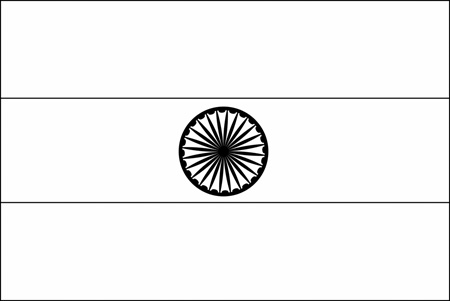
















No comments:
Post a Comment